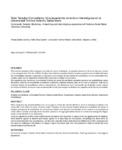Mostrar o rexistro simple do ítem
Taller Templos Comunitarios: una experiencia docente e inter-religiosa en la Universidad Técnica Federico Santa María
| dc.contributor.author | Bastías Gómez, Freddy | |
| dc.contributor.author | Silva Gopfert, Pablo | |
| dc.date.accessioned | 2019-06-12T11:25:51Z | |
| dc.date.available | 2019-06-12T11:25:51Z | |
| dc.date.issued | 2017 | |
| dc.identifier.citation | Bastías Gómez, F., & Silva Gopfert, P. (2017). Taller Templos Comunitarios. Actas De Arquitectura Religiosa Contemporánea, 5, 316-331. https://doi.org/10.17979/aarc.2017.5.0.5161 | es_ES |
| dc.identifier.issn | 2340-5503 | |
| dc.identifier.uri | http://hdl.handle.net/2183/23173 | |
| dc.description.abstract | [Resumen] Para diseñar cualquier edificio sagrado, no basta con revisar la literatura: se requiere observar el rito de la vida, aun cuando no se comparta su fe. Por ello, el Taller Templos Comunitarios consideró diseñar templos y espacios de sociabilización para las comunidades luterana, musulmana y masónica, en el contexto de una carrera de arquitectura, en una universidad laica creada a partir de una disposición testamentaria que aleja la religión de sus aulas.Una experiencia en donde las comunidades hicieron las veces de mandante, pudiendo explorar sus posibilidades reales de edificar, mientras los estudiantes accedieron a observar y diseñar espacios para un rito que no practican. Todo en un ambiente alejado de proselitismos, diverso culturalmente, con diferencias de fe, asumiendo que el desafío común a todos los credos es diseñar un espacio que se ausenta del mundo para acoger los rituales más sagrados de la vida en comunidad. | es_ES |
| dc.description.abstract | [Abstract] When designing any sacred building, it is not enough to review the relevant literature, but it is necessary to observe the ritual of life, even when one does not share a faith. Therefore, the Community Temples Workshop considered the design of temples and spaces of socialization for the Lutheran, Muslim and Masonic communities, in the context of an architectural career within a secular university, which has been passed on through generations based on a testament stating that religion would not be attached to its classrooms. It was an experience in which communities served as leaders with the power to explore their real opportunities for building,while students agreed to observe and design spaces for a ritual they did not practice. Everything was done within an environment detached from proselytizing, one that was culturally diverse and welcomed differences in faith, accepting that the common challenge of all creeds is to design a space that steps back from the mundane in order to cherish the most sacred rituals of community life | es_ES |
| dc.language.iso | spa | es_ES |
| dc.publisher | Universidade da Coruña | es_ES |
| dc.relation.uri | https://doi.org/10.17979/aarc.2017.5.0.5161 | es_ES |
| dc.rights | Atribución-NoComercial 4.0 España | es_ES |
| dc.rights.uri | http://creativecommons.org/licenses/by-nc/3.0/es/ | * |
| dc.subject | Templos comunitarios | es_ES |
| dc.subject | Universidad Técnica Federico Santa María | es_ES |
| dc.subject | Arquitectura religiosa | es_ES |
| dc.subject | Experiencia docente | es_ES |
| dc.subject | Experiencia interreligiosa | es_ES |
| dc.subject | Community temples | es_ES |
| dc.subject | Federico Santa María Technical University | es_ES |
| dc.subject | Sacred architecture | es_ES |
| dc.subject | Teaching experience | es_ES |
| dc.subject | Interreligious experience | es_ES |
| dc.title | Taller Templos Comunitarios: una experiencia docente e inter-religiosa en la Universidad Técnica Federico Santa María | es_ES |
| dc.title.alternative | Community Temples Workshop: A teaching and inter-religious experience at Federico Santa María Technical University | es_ES |
| dc.type | info:eu-repo/semantics/article | es_ES |
| dc.rights.access | info:eu-repo/semantics/openAccess | es_ES |
| UDC.journalTitle | Actas de Arquitectura Religiosa Contemporánea | es_ES |
| UDC.volume | 5 | es_ES |
| UDC.startPage | 316 | es_ES |
| UDC.endPage | 331 | es_ES |






